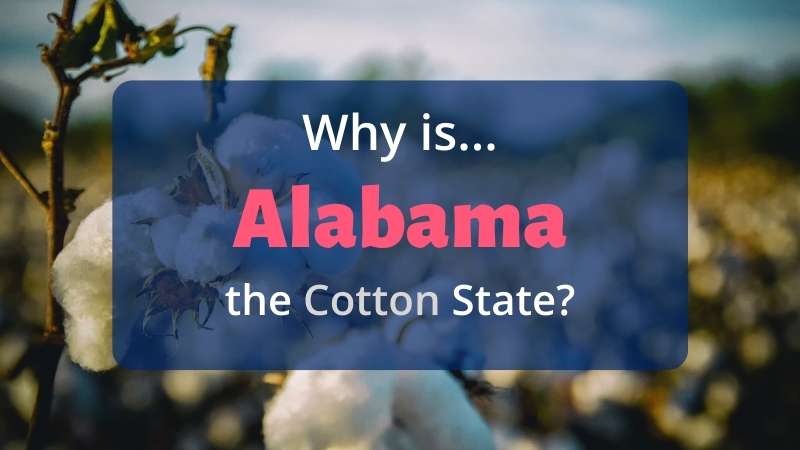Alabama, despite being the first state you see alphabetically, was actually the 22nd American state. Since this time, Alabama has adopted a few different nicknames, with “Cotton State” being one of the more notable ones, and it even used to be the official state nickname.
Reasons and popular theories why “cotton” became the nickname of Alabama are derived from the significance of cotton throughout the state’s history. Alabama has always been one of the largest cotton producers in North America, which helped massively in building up a strong economic foundation for the state.

While there are some southern U.S. states that are referred to as “Cotton Plantation States”, Alabama has been singled out as the main cotton state due to its central location in what many call the “Cotton Belt”.
Cotton used to be Alabama’s leading crop, and the state was considered to be the leading cotton producer. Nowadays, whilst still being a massive cotton distributor, the state has tapered off compared to others and is no longer the biggest cotton-producing state; however, it is still a top 10 cotton producer in the U.S. “Cotton State” was the state’s nickname before it became the yellowhammer state.
Why is Alabama the Cotton State?
Cotton really has played an instrumental part in Alabama becoming the state we know today. It was the early Native American tribes that started growing cotton, and soon after this, the Spanish and English colonists began growing it in Florida and Virginia.
Over the years, farmers and botanists have been experimenting with different varieties of cotton, and even crossbreeding certain strains on occasion to try and produce hardier types of cotton to survive in harsher environments and during different seasons.
Throughout pretty much the entire 1700s, cotton was a cottage industry, basically, a business or manufacturing activity that took place in someone’s home. This resulted in many colonists beginning to grow small amounts of cotton near their homes and spinning small amounts for their own personal usage.
The Industrial Revolution did bring many changes to the production of cotton. During the late 1700s, English inventors created and developed new methods of spinning raw cotton and wool into thread, easier and quicker than ever before. They were named “flying shuttle”, “spinning jenny”, and “power loom”, and they quickly began to transform the textile industry.
The famous Flying Shuttle was developed in the early 18th century by British inventor, John Kay, which unlocked a much quicker and more efficient way of the work practices and methodology of professional weavers. No longer would they need an apprentice to pull the weft thread through the wrap. This was a huge step toward automatic weaving.
The next machine was created in 1793, by inventor Eli Whitney, who invented the “Cotton Gin”. The Cotton Gin was created to perform the task of separating the seeds from the cotton, which to many, was incredibly time-consuming. Knock-offs of this machine were quickly produced in mass around the entire U.S. as a result of the Cotton Gin.
Exportation of cotton from Alabama started to rapidly increase over the next few decades as a result of these inventions. By the time 1839 rolled around, Mobile, AL, was shipping over 400,000 bales of cotton, which represented half of the cotton exports for the entire nation!
As more advanced equipment and the usage of fertilizer became more common, not to mention an improved agricultural education system, the production of cotton just kept on rolling, becoming more and more successful by the day.

However, perhaps the biggest factor in Alabama’s cotton-producing success was slavery. Due to cotton growing and picking being so intense and requiring a lot of labor, landowners used their slave populations to produce large crops of cotton each year for no pay and simply a small room with minimal food.
By 1860, the population of Alabama had increased to a staggering 964,000 people, and almost half of them were, unfortunately, slaves!
History of the Cotton State
The Civil War absolutely destroyed the cotton industry in Alabama. Soldiers would destroy the cotton fields and blockade the southern ports in the state, reducing the ability of exportation tremendously.
When the North was announced victorious, slavery was abolished and outlawed. Farmers ended up replacing slavery with a tenant system, where ex-slaves and whites without land or money worked on small plots of plantation owners’ land.
The plantation owners expected their tenants to pay for all of the farming expenses themselves and they wanted rent money and also 50% of the harvest. Naturally, this system was simply not fair to the workers and would often lead to tenants getting themselves into massive debt. It is known as sharecropping.
Despite this new system being seemingly cost-effective, it still took Alabama 30 years to return to the level of cotton production they were reaching before the Civil War.
America’s cotton industry hit an all-time high during the 1890s, with exports of around 3,000,000 bales. Eventually, the United States government opened agricultural bureaus to ensure that cotton production was as efficient as it possibly could be.
Alabama’s nickname and title, the Cotton State came to an end during the 20th century. Cotton boil weevils arrived in Alabama in 1911, and the tenant farmers were hit the hardest, forcing many of them to move North in search of more fruitful opportunities.
The plantation farmers were losing tenants and capital at the same time due to the slowing of cotton production. So, they needed to start diversifying their produce, starting by investing in other industries.
Cotton production began moving to the west, and Alabama’s agricultural incentives began changing, producing soybeans, poultry, and cattle, with the remaining cotton plantations becoming large mechanized businesses.
FAQs (Frequently Asked Questions)
If you want to learn even more history and information, we have some answers to frequently asked questions regarding why Alabama was nicknamed the Cotton State.
Is Alabama still the Cotton State?
No, Alabama is no longer nicknamed the cotton state, despite it being one of the most iconic nicknames gifted to any state. After Alabama lost the nickname Cotton State, it gained the nickname Yellowhammer State.
What are the 3 nicknames of Alabama?
There are 3 main and significant nicknames that have been given to Alabama over the past several years. The most commonly known is the “Yellowhammer State,” and the other two are “Heart of Dixie” and “Cotton State.”
Are any other states called the Cotton State?
No, there is and has only ever been one state with the official nickname “Cotton State” and that is sweet home Alabama!


